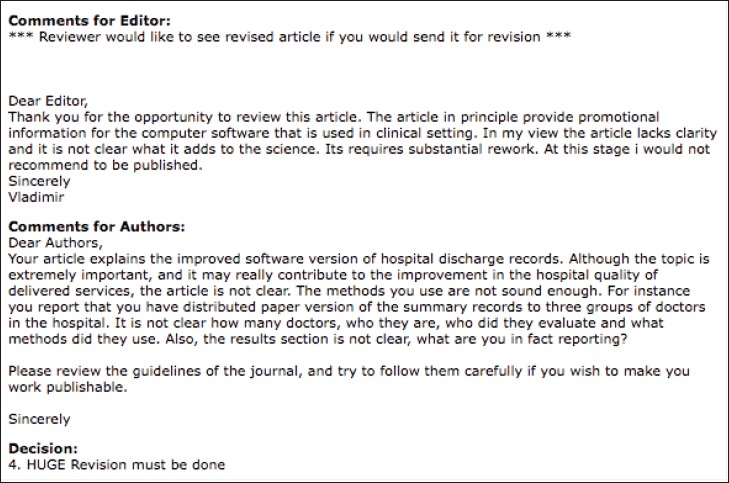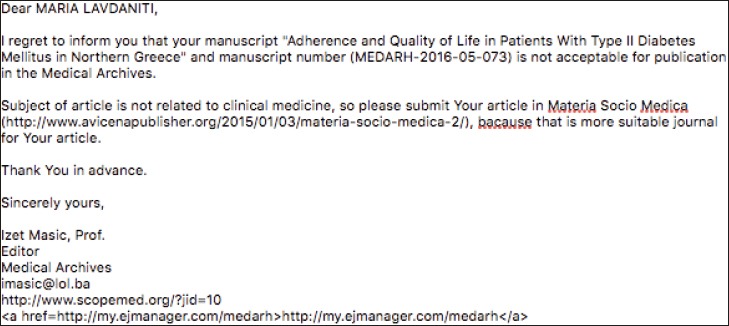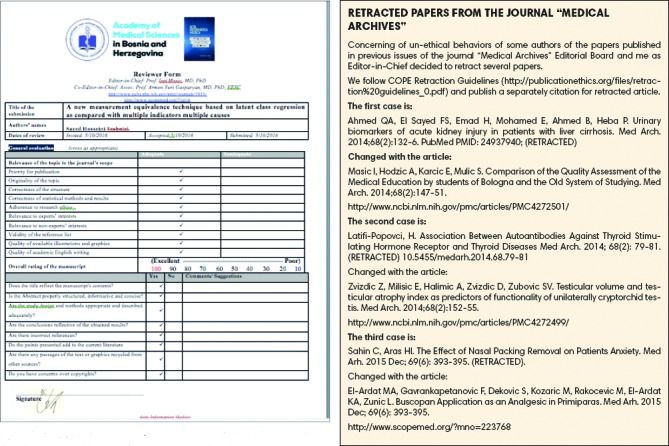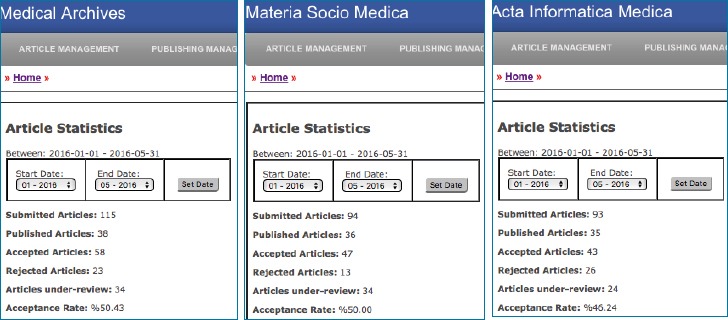Peer review is at the heart of the processes of not just medical journals but of all of science. It is the method by which grants are allocated, papers published, academics promoted, and Nobel prizes won (1). Each article, which is submitted for publication in a particular journal, according to the ethical and the established standards of practice, must pass through a peer-review process (2-7). The articles go through a peer-review process, without the authors’ names, and this is essentially a blind process. Common practice is to peer-review an article by two experts, prominent enough for scholarly careers in the field from which the article comes. Through years-long experience of the editor, of several journals, I think that a search for an appropriate peer-reviewer is the most complex part in the scope of responsibilities of the editor. Theoretically, everyone wants gladly to review particular article. The higher the impact factor of the journal is, this desire grows. In practice, every fourth petition for review of a certain work is accepted (8-12). Editors are faced with many dilemmas and primarily, through the numerous e-mails, they reach a certain reviewer, after a period, which sometimes last up to a year. Sometimes this review contains only two sentences, and the editor is forced to look for new potential reviewer as a decision on the work cannot be made, on the basis of two sentences. Each reviewer receives copy of the journal, for which he/she writes its opinion on the above-mentioned work.
The most frequent comments are:
-
a)
The work has a descriptive character, does not represent any added value to the scientific community, and that does not meet standards;
-
b)
The work methodology is not according to the instructions of the journal;
-
c)
The work is not consistent with the other results of the process mentioned;
-
d)
Language of work does not correspond to the highest standards of academic community;
-
e)
Statistical analysis has not brought any significant result, which could contribute to the scientific community;
-
f)
The work requires additional material, which could explain the results.
After the review results and insight into the work, editor rejects or accepts a certain article. The fact is that almost every rejected article, be accepted and published in another journal. While it is undeniable that the indexation of the journal is crucial to article on the CC list are the most prestigious academic community (extremely important to progress in academic careers), these works mostly are inaccessible to the wider community, which tend to approach these paid articles. The broader community, students, and even teachers of the third world, and teachers in the countries in transition and developing countries, does not have access to these works, and they turn toward all the other, free access available articles. Modern technology, the Internet, and especially GoogleScholar, allows access to all these articles, where the teachings of the essence and there, and even less originality, to get a simple search on the air, that is, to quote the fact that they are used to raise rating and questionable research. Job of peer reviewers for these works essentially lost its importance. Of course, this rule does not apply to journals with the highest rating, because the publishing carries prestige in itself, but they sometimes come least in everyday practice. Some works that are rejected, and then send to another journal, which still requires greater processing fee, will be accepted, although the impact factor of the journal of the second one is higher. We come to the conclusion that money still plays a greater role here. Through years of practice, I have come to the conclusion that the country of origin of the author, plays a major role, especially in journals with lower Impact Factor, and in journals from undeveloped, so-called small countries. Fellow editors, through informal discussions, acknowledged that it is essentially choosing less strict reviewer, pulls and allows the publication of works, from the developed countries of the world, as it hopes to increase the chances of publishing in indexed journal. We must be aware that reviewers have their primary job, which brings them necessary income, and to review an article, requires a long time, and sometimes they just do not do it thoroughly. On the other hand, overproduction of works and growing number of periodicals, emphasized the insufficient number of available reviewers, and reduce the possibility of quality and quick review. If respected some standards, the author of his/her own experience argues that only one in five reviews is helpful and with appropriate quality and that every fifth review provides quality instruction to the author for any corrections of the work or suggests to the editor quality information and backing for the rejection or acceptance of the article.
Table 1.
The list of reviewers of of AMNUBiH Sarajevo journals during period 01.01.2016. - 25.05.2016.

The situation of reviewers availability have been improved in the last two years with introducing Publons database (13). The mission of Publons is to improve the peer review process by giving reviewers a verified record of the work they do for journals. Peer review constitutes an important contribution to science and Publons intends to motivate and help academics demonstrate their experience with the activity. It’s completely free for reviewers, by using Publons, to showcase their peer review activity and to build an official review record to be placed in their own résumé. In addition, reviewers, editors, authors, and other readers can join in the post-publication discussion of articles on the Publons platform.
Once the reviewer just did not have the expertise to do the review (especially in the field of clinical medicine), regardless of their academic title, but there is a conflict between the author and reviewer. One should always bear in mind, especially in transition countries, and especially in clinical medical disciplines to the academic advancement and specialist expertise, two diametrically different things, although unfortunately academic title is placed before specialist expertise, in terms of choosing management positions, thus forget the very purpose of medicine. Possible options, that is the way, was the continuing education of the reviewers, or training for the reviewer, crowding out additional funds, you probably seldom that the journal, which is published in printed and electronic form, cannot afford. Peer review process requires many improvements, especially in the minds of the academic community.
Figure 1.

Screen shot of one reviewer’s comment to the editor and to the author of the submitted article (ejmanager.com platform)
Figure 2.

Article is rejected because subject of article is more suitable for another journal
Figure 3.

Screenshot of one reviewer’s comment to the editor of the Acta Informatica Medica (MS Word form; archived in database of journal)
Figure 4.

Statistical data about received, accepted and rejected papers in AMN journals
Impatience of the authors, procrastination of the reviewer, makes editor job impossible. Software solutions are now at fingertips in every sphere of life, or software solutions are of little help in the triangle editor-reviewer-author, as though one should always keep in mind that the academic community is quite vain. In countries in transition from hard experience, and I presume in developed countries, many authors on the basis of friendship with the Editorial Board members may publish their research, trough the less strict process. Sometimes fundamental ethical principles have been disregard. Less quality work sometimes easier and faster passes, if the author is from the same country from where the journal is printed. The big problem to editor also represent numerous co-authorship without following principles and the most recent developments for allocating authorship (14, 15). It is not normal for a review or short article with 4 pages written to have 11 authors. Many co-authorships are often at the international level (collaboration of hundreds of authors in some projects), believing it raises the rating of the first author. In fact, sometimes it gets to the point that these strong co-authors have no idea that such paper was prepared and published with their names as co-authors. However, collaboration is generally accepted to be quoted and, in the minds of other authors, co-authorships are very important, which rise of their rating, and the growth of numerous scientometric indices of the author. In essence, in most of the cases there is no real basis for it. Acceptance rate of each journal, should be information that will stand in the first row of the description of the journal, because through it can be a lot to learn about the criteria and possibility of accepting the manuscript for review and publication in the journal. In the minds of the authors, acceptance rate, indicates the quality of the journal, to be all down the lower acceptance rate, the higher the impact factor, which is still in fact wrong.
Perhaps it would be best to introduce the practice to the introduction of each work clearly shows that this work is important, and how it contributes to, and thus would clearly facilitate the work and editor and reviewer. The fact is that the acceptance rate, is the biggest landmark for selection journal for indexation. For sure, filtering of works is undeniably important, but always should bear in mind, that science is not there to bring the money., because if you can pay all, then probably all the sense of losing, and neither is true. The science is there to help the development of civilization and to make the world a better place to live. The development of the Internet, the development of the various platforms on which is able to share articles and the latest knowledge, business review and a variety of base will lose its significance, in addition to universities and academic institutions, where it still looks the quantity of publications for the purpose of promotion (sometimes rapid progression) but the quality remains low. Many professors, academics, should be realistic, and look at themselves and then their colleagues, and ask whether their research really so essential and important and whether it contributed to development of a science field, at least in their own country, because that was, also, really a great success.
Footnotes
• Conflict of interest: None declared.
REFERENCES
- 1.Smith R. Peer review:a flawed process as the heart of science and journals. Journal of the Royal Society of Medicine. 2006;99(4):178–82. doi: 10.1258/jrsm.99.4.178. [DOI] [PMC free article] [PubMed] [Google Scholar]
- 2.Bohannon J. Who’s Afraid of Peer Review? Science. 2013 Oct 4th;342:60–5. doi: 10.1126/science.2013.342.6154.342_60. [DOI] [PubMed] [Google Scholar]
- 3.Masic I. How to Search, Write, Prepare and Publish the Scientific Papers in the Biomedical Journals. Acta Inform Med. 2011 Jul;19(2):68–79. doi: 10.5455/aim.2011.19.68-79. doi:10.5455/aim.2011.19.68-79. [DOI] [PMC free article] [PubMed] [Google Scholar]
- 4.Masic I. Scientometric Analysis:analysis:a technical need for medical science researchers either as authors or as peer reviewers. J Res Pharm Pract. 2016 Jun-Mar;5(1):1–6. doi: 10.4103/2279-042X.176562. 10.41103/2279-042X.176562. [DOI] [PMC free article] [PubMed] [Google Scholar]
- 5.Masic I. A New Example of Un-ethical Behaviour in the Academic Journal “Medical Archives”. 2014 Aug;68(4):228–30. doi: 10.5455/medarh.2014.68.228-230. doi:10.5455/medarh.2014.68.228-230. [DOI] [PMC free article] [PubMed] [Google Scholar]
- 6.Masic I, Sabzghabaee AM. How clinicians can validate scientific contents? J Res Med Sci. 2014 Jul;19(7):583–5. [PMC free article] [PubMed] [Google Scholar]
- 7.Donev D. Principles and ethics in scientific communication in biomedicine. Acta Inform Med. 2013;21(4):228–33. doi: 10.5455/aim.2013.21.228-233. [DOI] [PMC free article] [PubMed] [Google Scholar]
- 8.Masic I. Medical Publication and Scientometrics. J Res Med Sci. 2013 Jun;18(6):516–21. [PMC free article] [PubMed] [Google Scholar]
- 9.Masic I. The Importance of Proper Citation of References in Biomedical Articles. Acta Inform Med. 2013;21(3):148–55. doi: 10.5455/aim.2013.21.148-155. [DOI] [PMC free article] [PubMed] [Google Scholar]
- 10.Masic I. Plagiarism in Scientific Publishing. Acta Inform Med. 2012 Dec;20(4):208–13. doi: 10.5455/aim.2012.20.208-213. doi:10.5455/aim.2013.20.208-213. [DOI] [PMC free article] [PubMed] [Google Scholar]
- 11.Masic I. Ethical Aspects and Dilemmas of Preparing, Writing and Publishing of the Scientific Papers in the Biomedical Journals. Acta Inform Med. 2012 Sep;20(3):141–8. doi: 10.5455/aim.2012.20.141-148. doi:10.5455/aim.2012.20.141.148. [DOI] [PMC free article] [PubMed] [Google Scholar]
- 12.Masic I, Begic E. Scientometric Analysis of the Journals of the Academy of Medical Sciences in Bosnia and Herzegovina. Acta Inform Med. 2016 Feb;24(1):4–10. doi: 10.5455/aim.2016.24.4-11. doi:10.5455/aim.2016.24.4-9. [DOI] [PMC free article] [PubMed] [Google Scholar]
- 13.Richard Van Noorden. The scientists who get credit for peer review Nature, Oct 9th 2014. doi:10.1038/nature.2014.16102. Available at: http://www.nature.com/news/the-scientists-who-get-credit-for-peer-review-1.16102 .
- 14.Donev D. New developments in publishing related to authorship. Prilozi - Contributions, Sec Biol Med Sci. MASA. 2014;35(3):57–66. doi: 10.1515/prilozi-2015-0009. Available at: http://manu.edu.mk/prilozi/35_3/09-D_DONEV.pdf . [DOI] [PubMed] [Google Scholar]
- 15.Masic I, Kujundzic E. Science Editing in Biomedicine and Humanities. Avicena. Sarajevo. 2013:51–66. ISBN 978-9958-720-49-9. [Google Scholar]


